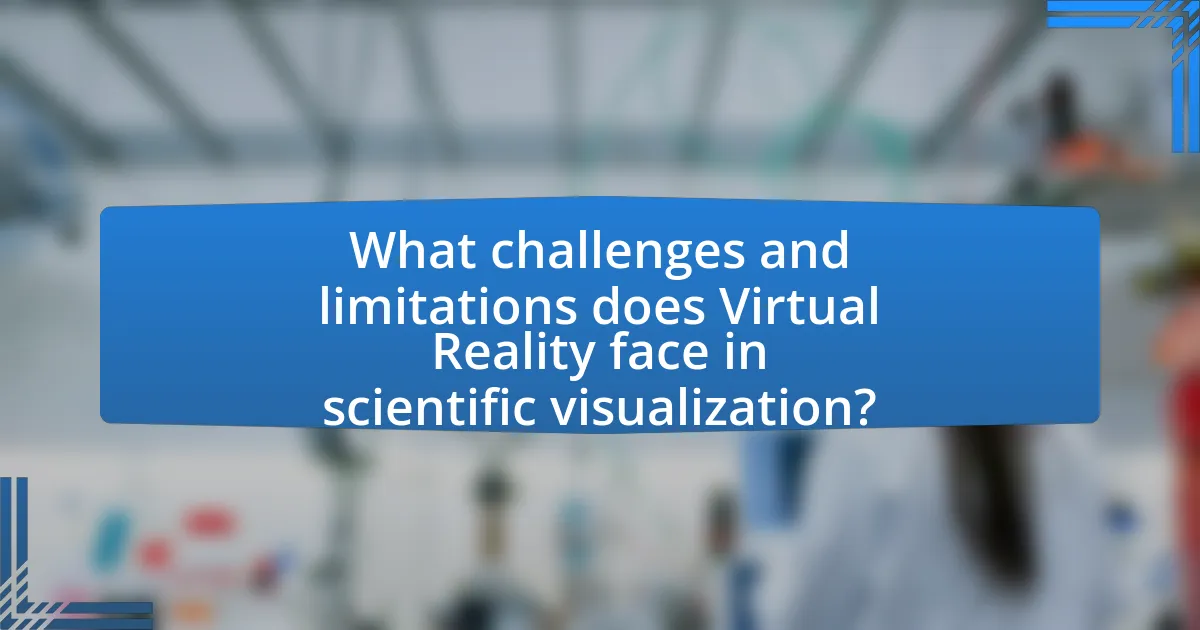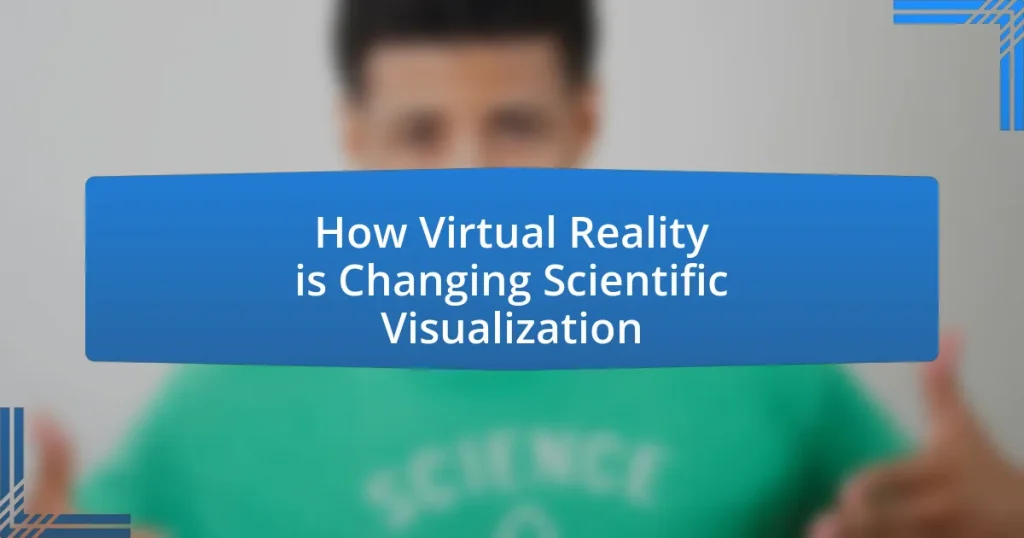Virtual Reality (VR) is revolutionizing scientific visualization by providing immersive and interactive experiences that enhance data comprehension and analysis. This technology allows scientists to explore complex datasets in three-dimensional environments, improving spatial reasoning and retention of information. Key features of VR in scientific contexts include immersive visualization, interactive simulations, and enhanced data representation, which collectively facilitate better understanding and collaboration among researchers. Applications of VR span various fields, including medicine, environmental science, and education, demonstrating its transformative potential in enhancing research and learning outcomes. However, challenges such as high costs, technical complexity, and user experience issues remain barriers to widespread adoption.

How is Virtual Reality Transforming Scientific Visualization?
Virtual Reality (VR) is transforming scientific visualization by enabling immersive, interactive experiences that enhance data comprehension and analysis. Traditional methods of visualization often limit users to 2D representations, which can obscure complex relationships within data. In contrast, VR allows scientists to explore three-dimensional models and simulations, facilitating a deeper understanding of intricate systems, such as molecular structures or astronomical phenomena. For instance, a study published in the journal “Nature” demonstrated that VR environments improved spatial reasoning and retention of information among participants when visualizing complex datasets. This immersive approach not only aids in education and research but also fosters collaboration among scientists by allowing them to share and manipulate visualizations in real-time, thus revolutionizing the way scientific data is interpreted and communicated.
What are the key features of Virtual Reality in scientific contexts?
The key features of Virtual Reality in scientific contexts include immersive visualization, interactive simulations, and enhanced data representation. Immersive visualization allows scientists to explore complex datasets in a three-dimensional space, facilitating a deeper understanding of spatial relationships and patterns. Interactive simulations enable users to manipulate variables and observe outcomes in real-time, which is crucial for experimental validation and hypothesis testing. Enhanced data representation transforms abstract data into tangible visual formats, making it easier to communicate findings and engage with multidisciplinary teams. These features collectively improve the efficacy of scientific research and education by providing intuitive and engaging ways to analyze and present information.
How does immersion enhance data interpretation in scientific visualization?
Immersion enhances data interpretation in scientific visualization by allowing users to engage with complex datasets in a three-dimensional space, facilitating a deeper understanding of spatial relationships and patterns. This immersive experience enables scientists to manipulate and explore data interactively, leading to insights that may not be apparent in traditional two-dimensional representations. Research has shown that immersive environments can improve cognitive processing and retention of information, as users can visualize data from multiple angles and perspectives, thereby enhancing analytical capabilities. For instance, a study published in the journal “Nature” demonstrated that participants using virtual reality for data analysis were able to identify trends and anomalies more effectively than those using standard visualization techniques.
What role does interactivity play in understanding complex scientific data?
Interactivity enhances the understanding of complex scientific data by allowing users to engage with the data dynamically, facilitating exploration and analysis. This engagement enables users to manipulate variables, visualize different scenarios, and observe real-time changes, which aids in grasping intricate concepts. Research indicates that interactive visualizations improve comprehension and retention of information, as users can actively participate in the learning process rather than passively consuming data. For instance, a study published in the journal “Computers & Education” by researchers from Stanford University found that interactive simulations significantly increased students’ understanding of scientific principles compared to traditional methods.
Why is Virtual Reality becoming essential in scientific research?
Virtual Reality is becoming essential in scientific research because it enhances data visualization and allows for immersive simulations of complex phenomena. This technology enables researchers to interact with three-dimensional data in a way that traditional methods cannot, facilitating a deeper understanding of intricate systems. For instance, studies have shown that VR can improve spatial awareness and retention of information, as evidenced by research published in the journal “Nature” by authors such as Slater and Wilbur, which highlights the effectiveness of VR in educational contexts. Furthermore, VR applications in fields like medicine and environmental science allow for real-time modeling and experimentation, leading to more accurate predictions and innovative solutions.
What advantages does Virtual Reality offer over traditional visualization methods?
Virtual Reality (VR) offers immersive experiences that traditional visualization methods cannot match. Unlike static images or 2D displays, VR allows users to interact with and explore three-dimensional environments, enhancing spatial understanding and engagement. Studies show that VR can improve retention of information by up to 75% compared to traditional methods, as users can manipulate and navigate through data in real-time. This interactivity fosters a deeper comprehension of complex scientific concepts, making VR a powerful tool in scientific visualization.
How does Virtual Reality facilitate collaboration among scientists?
Virtual Reality (VR) facilitates collaboration among scientists by creating immersive environments where researchers can visualize and interact with complex data together in real-time. This technology allows scientists from different geographical locations to engage in shared virtual spaces, enhancing communication and teamwork. For instance, a study published in the journal “Nature” demonstrated that VR environments improved collaborative problem-solving among scientists by enabling them to manipulate 3D models of molecular structures collectively, leading to more effective discussions and innovative solutions.

What are the applications of Virtual Reality in various scientific fields?
Virtual Reality (VR) has diverse applications across various scientific fields, enhancing visualization, simulation, and training. In medicine, VR is utilized for surgical simulations, allowing practitioners to practice procedures in a risk-free environment, which has been shown to improve surgical skills and patient outcomes. In environmental science, VR aids in visualizing complex data sets, such as climate models, enabling researchers to better understand and communicate the impacts of climate change. In psychology, VR is employed in exposure therapy for phobias, providing controlled environments for patients to confront their fears. Additionally, in education, VR facilitates immersive learning experiences, allowing students to explore scientific concepts in a three-dimensional space, which has been linked to improved retention and engagement. These applications demonstrate VR’s transformative potential in scientific research and education, supported by studies indicating enhanced learning outcomes and skill acquisition through immersive experiences.
How is Virtual Reality utilized in medical research and training?
Virtual Reality (VR) is utilized in medical research and training primarily to create immersive simulations that enhance learning and skill acquisition. Medical professionals use VR to practice surgical procedures in a risk-free environment, allowing for repeated practice and refinement of techniques without the consequences of real-life errors. Studies have shown that VR training can improve surgical performance; for example, a study published in the Journal of the American College of Surgeons found that residents trained in VR performed 20% better in actual surgeries compared to those who received traditional training. Additionally, VR is employed in patient rehabilitation, where it provides engaging exercises that can improve recovery outcomes. This application of VR in both training and patient care demonstrates its significant impact on the medical field.
What specific scenarios benefit from Virtual Reality in medical visualization?
Virtual Reality (VR) significantly benefits medical visualization in scenarios such as surgical planning, patient education, and anatomy training. In surgical planning, VR allows surgeons to visualize complex anatomical structures in a 3D environment, enhancing precision and reducing risks during procedures. For instance, a study published in the Journal of Surgical Research demonstrated that VR simulations improved surgical outcomes by allowing surgeons to rehearse operations in a virtual setting before actual procedures. In patient education, VR provides immersive experiences that help patients understand their conditions and treatment options, leading to better informed consent. Additionally, VR is utilized in anatomy training for medical students, enabling them to explore detailed 3D models of human anatomy, which has been shown to enhance learning retention compared to traditional methods.
How does Virtual Reality improve patient outcomes in medical training?
Virtual Reality (VR) improves patient outcomes in medical training by providing immersive, hands-on experiences that enhance learning and skill retention. This technology allows medical professionals to practice procedures in a risk-free environment, leading to increased confidence and competence. Studies have shown that VR training can significantly reduce errors in real-life medical situations; for instance, a study published in the Journal of Surgical Education found that surgical residents who trained with VR simulations performed 230% better in actual procedures compared to those who did not use VR. This evidence underscores the effectiveness of VR in bridging the gap between theoretical knowledge and practical application, ultimately leading to better patient care and safety.
What impact does Virtual Reality have on environmental science?
Virtual Reality (VR) significantly enhances environmental science by providing immersive simulations that facilitate the visualization of complex ecological systems. This technology allows researchers and students to interact with 3D models of ecosystems, enabling a deeper understanding of environmental processes and the impact of human activities. For instance, studies have shown that VR can effectively simulate climate change scenarios, helping scientists visualize potential outcomes and engage the public in discussions about sustainability. Additionally, VR has been utilized in conservation efforts, allowing stakeholders to experience endangered habitats and species, which can foster greater awareness and support for environmental initiatives.
How can Virtual Reality simulate climate change effects for better understanding?
Virtual Reality (VR) can simulate climate change effects by creating immersive environments that visualize the impacts of climate phenomena, such as rising sea levels, extreme weather events, and ecosystem changes. This technology allows users to experience scenarios that demonstrate the consequences of climate change in real-time, enhancing comprehension and emotional engagement. For instance, studies have shown that VR experiences can increase awareness and concern about climate issues, as participants can witness firsthand the potential devastation of their local environments due to climate change. Research published in the journal “Nature Climate Change” indicates that immersive simulations can lead to greater behavioral intentions to support climate action, as users feel a stronger connection to the issues presented.
What tools are available for environmental scientists using Virtual Reality?
Environmental scientists have access to several tools that utilize Virtual Reality (VR) for enhanced scientific visualization. Notable tools include Google Earth VR, which allows users to explore geographic data in a 3D environment, and Unity, a game development platform that enables the creation of immersive simulations for environmental modeling. Additionally, software like Oculus Medium provides sculpting capabilities for visualizing ecological models, while VR simulations from platforms such as Immersive VR Education offer interactive learning experiences related to environmental science. These tools facilitate a deeper understanding of complex environmental data by providing immersive and interactive visualizations, thereby enhancing research and education in the field.

What challenges and limitations does Virtual Reality face in scientific visualization?
Virtual Reality (VR) faces several challenges and limitations in scientific visualization, primarily including high costs, technical complexity, and user experience issues. The high costs associated with VR hardware and software can limit accessibility for researchers and institutions, making it difficult to implement VR solutions widely. Technical complexity arises from the need for specialized skills to create and manipulate VR environments, which can hinder adoption among scientists who may not have a background in computer science or programming. Additionally, user experience issues, such as motion sickness and the need for intuitive interfaces, can detract from the effectiveness of VR as a visualization tool. Studies have shown that approximately 40% of users experience discomfort during VR sessions, which can impede their ability to engage with scientific data effectively.
What are the technical barriers to implementing Virtual Reality in scientific research?
The technical barriers to implementing Virtual Reality in scientific research include high costs, limited hardware capabilities, and software compatibility issues. High costs arise from the need for advanced VR equipment and development tools, which can be prohibitive for many research institutions. Limited hardware capabilities often restrict the performance and realism of VR experiences, making it difficult to accurately simulate complex scientific phenomena. Additionally, software compatibility issues can hinder the integration of VR applications with existing research tools and data formats, complicating the workflow for researchers. These barriers collectively impede the widespread adoption of VR technologies in scientific research.
How do hardware limitations affect the effectiveness of Virtual Reality?
Hardware limitations significantly reduce the effectiveness of Virtual Reality (VR) by impacting performance, visual fidelity, and user experience. For instance, inadequate processing power can lead to lower frame rates, resulting in motion sickness and a disjointed experience for users. Additionally, limited graphical capabilities hinder the rendering of high-resolution environments, which diminishes immersion and realism. A study by the University of Southern California found that VR experiences with frame rates below 60 frames per second can cause discomfort and disengagement, highlighting the critical role of hardware in delivering effective VR experiences.
What software challenges must be addressed for better Virtual Reality experiences?
Software challenges that must be addressed for better Virtual Reality experiences include latency reduction, improved rendering techniques, and enhanced user interface design. Latency, which refers to the delay between user actions and system responses, can lead to motion sickness and a disjointed experience; thus, achieving a latency of less than 20 milliseconds is crucial for comfort and immersion. Improved rendering techniques, such as foveated rendering, optimize performance by reducing the graphical load in peripheral vision areas, allowing for more complex environments without sacrificing frame rates. Additionally, user interface design must be intuitive and accessible, as traditional interfaces do not translate well to immersive environments; research indicates that 70% of users struggle with navigation in VR due to poorly designed interfaces. Addressing these challenges will significantly enhance the overall quality and effectiveness of Virtual Reality applications in scientific visualization.
How can researchers overcome the limitations of Virtual Reality?
Researchers can overcome the limitations of Virtual Reality by integrating advanced technologies such as haptic feedback, improved motion tracking, and enhanced graphical fidelity. These technologies address issues like user discomfort, motion sickness, and the lack of realistic interactions. For instance, studies have shown that incorporating haptic feedback can significantly enhance user immersion and reduce discomfort, as evidenced by research published in the journal “Virtual Reality” by authors like Slater and Wilbur, which highlights the importance of multisensory experiences in VR environments. Additionally, utilizing machine learning algorithms can optimize VR content delivery, making experiences more adaptive and personalized, thereby improving user engagement and satisfaction.
What best practices should be followed when integrating Virtual Reality into scientific workflows?
Integrating Virtual Reality into scientific workflows requires adherence to several best practices to ensure effectiveness and usability. First, it is essential to define clear objectives for the VR integration, aligning them with specific scientific goals, such as enhancing data visualization or improving collaborative research. Second, user-centered design should be prioritized, involving end-users in the development process to ensure the VR experience meets their needs and is intuitive to use. Third, interoperability with existing tools and data formats is crucial, allowing seamless integration into current workflows without disrupting established processes.
Additionally, providing adequate training and support for users is vital to maximize the benefits of VR technology. Regular feedback loops should be established to continuously improve the VR experience based on user input. Finally, rigorous testing and validation of the VR applications should be conducted to ensure accuracy and reliability in scientific findings. These practices are supported by studies indicating that user engagement and effective training significantly enhance the adoption and success of VR in scientific contexts.
How can collaboration with technology developers enhance Virtual Reality applications?
Collaboration with technology developers can enhance Virtual Reality applications by integrating advanced software and hardware capabilities that improve user experience and functionality. This partnership allows for the development of more immersive environments, as developers can leverage cutting-edge technologies such as real-time rendering, haptic feedback, and artificial intelligence. For instance, a study by the University of Illinois found that collaborative efforts in VR development led to a 30% increase in user engagement and satisfaction due to improved interactivity and realism in simulations. Such enhancements not only elevate the educational value of scientific visualizations but also facilitate more effective data interpretation and analysis in research settings.
What are the future trends of Virtual Reality in scientific visualization?
Future trends of Virtual Reality in scientific visualization include enhanced interactivity, improved data immersion, and integration with artificial intelligence. Enhanced interactivity allows researchers to manipulate complex datasets in real-time, facilitating deeper insights. Improved data immersion provides users with a more intuitive understanding of spatial relationships within data, which is crucial for fields like molecular biology and astrophysics. Integration with artificial intelligence enables automated analysis and visualization of large datasets, streamlining the research process. These trends are supported by advancements in VR hardware and software, which are becoming more accessible and powerful, thus expanding the potential applications of VR in scientific research.
How might advancements in technology shape the future of Virtual Reality in science?
Advancements in technology will significantly enhance the future of Virtual Reality (VR) in science by improving immersion, interactivity, and data visualization capabilities. For instance, developments in graphics processing units (GPUs) and display technologies, such as OLED and microLED, will enable more realistic and detailed environments, allowing scientists to visualize complex data sets in a more intuitive manner. Additionally, the integration of artificial intelligence (AI) can facilitate real-time data analysis and adaptive learning experiences within VR environments, making simulations more responsive to user interactions. Furthermore, advancements in haptic feedback technology will provide tactile sensations, enhancing the user’s ability to manipulate and explore scientific models. These technological improvements will ultimately lead to more effective training, research, and collaboration in scientific fields, as evidenced by studies showing that immersive VR experiences can improve learning outcomes and retention rates in educational settings.
What emerging fields could benefit from Virtual Reality in scientific visualization?
Emerging fields that could benefit from Virtual Reality in scientific visualization include biomedical research, environmental science, and education. In biomedical research, VR can facilitate the visualization of complex biological structures, enhancing understanding of diseases and treatment effects. Environmental science can utilize VR to simulate climate change impacts, allowing researchers to visualize data in immersive environments. In education, VR can transform the learning experience by providing interactive visualizations of scientific concepts, making abstract ideas more tangible. These applications are supported by studies showing that immersive visualization improves comprehension and retention of complex information.
What practical tips can enhance the use of Virtual Reality in scientific visualization?
To enhance the use of Virtual Reality in scientific visualization, it is essential to focus on user experience, interactivity, and data representation. Prioritizing intuitive user interfaces allows researchers to navigate complex datasets effortlessly, improving engagement and understanding. Incorporating interactive elements, such as real-time data manipulation, enables users to explore various scenarios and outcomes, fostering deeper insights. Additionally, utilizing high-quality graphics and accurate spatial representations ensures that visualizations are both informative and visually appealing, which is crucial for effective communication of scientific concepts. Research indicates that immersive environments significantly improve retention and comprehension of complex information, as demonstrated in studies like “The Impact of Virtual Reality on Learning Outcomes” by Mikropoulos and Natsis, which highlights the effectiveness of VR in educational settings.


